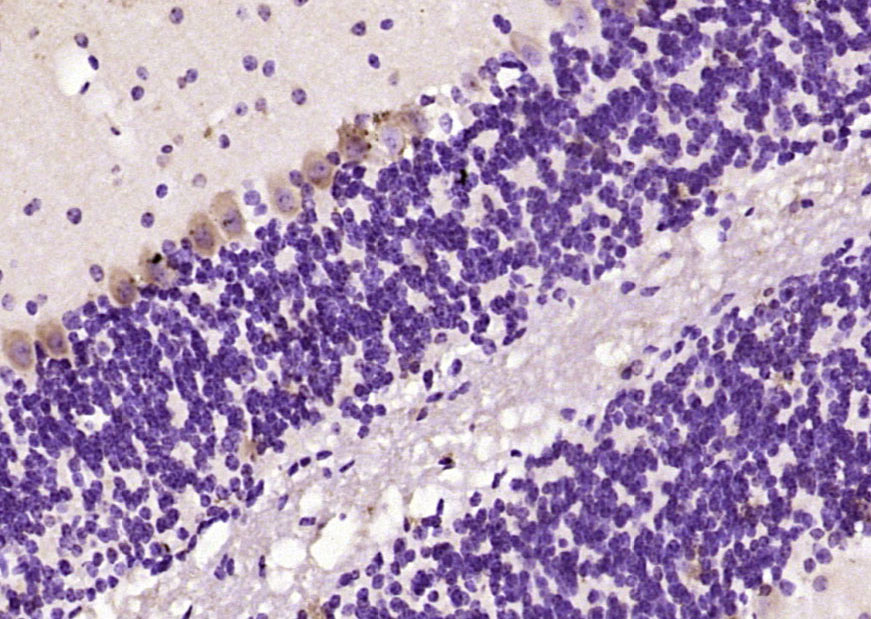
Rabbit Anti-RNF11 antibody
CGI 123; RING finger protein 11; RNF11; RNF11_HUMAN; Sid 1669; SID1669.
View History [Clear]
Details
Product Name RNF11 Chinese Name Ring finger protein11抗体 Alias CGI 123; RING finger protein 11; RNF11; RNF11_HUMAN; Sid 1669; SID1669. Research Area Cell biology immunology Epigenetics Immunogen Species Rabbit Clonality Polyclonal React Species Mouse, (predicted: Human, Rat, Chicken, Dog, Cow, Horse, Rabbit, Sheep, ) Applications ELISA=1:5000-10000 IHC-P=1:100-500 IHC-F=1:100-500 IF=1:50-200 (Paraffin sections need antigen repair)
not yet tested in other applications.
optimal dilutions/concentrations should be determined by the end user.Theoretical molecular weight 11kDa Cellular localization The nucleus cytoplasmic Form Liquid Concentration 1mg/ml immunogen KLH conjugated synthetic peptide derived from human RNF11: 65-154/154 Lsotype IgG Purification affinity purified by Protein A Buffer Solution 0.01M TBS(pH7.4) with 1% BSA, 0.03% Proclin300 and 50% Glycerol. Storage Shipped at 4℃. Store at -20 °C for one year. Avoid repeated freeze/thaw cycles. Attention This product as supplied is intended for research use only, not for use in human, therapeutic or diagnostic applications. PubMed PubMed Product Detail The protein encoded by this gene contains a RING-H2 finger motif, which is known to be important for protein-protein interactions. The expression of this gene has been shown to be induced by mutant RET proteins (MEN2A/MEN2B). The germline mutations in RET gene are known to be responsible for the development of multiple endocrine neoplasia (MEN). [provided by RefSeq, Jul 2008]
Function:
Essential component of a ubiquitin-editing protein complex, comprising also TNFAIP3, ITCH and TAX1BP1, that ensures the transient nature of inflammatory signaling pathways. Promotes the association of TNFAIP3 to RIPK1 after TNF stimulation. TNFAIP3 deubiquitinates 'Lys-63' polyubiquitin chains on RIPK1 and catalyzes the formation of 'Lys-48'-polyubiquitin chains. This leads to RIPK1 proteasomal degradation and consequently termination of the TNF- or LPS-mediated activation of NF-kappa-B. Recruits STAMBP to the E3 ubiquitin-ligase SMURF2 for ubiquitination, leading to its degradation by the 26S proteasome.
Subunit:
Interacts (when phosphorylated) with 14-3-3. Interacts with the E3 ubiquitin-ligases NEDD4, ITCH, SMURF2 and WWP1 (By similarity). Also interacts with the E2 ubiquitin-conjugating enzymes UBE2D1 and UBE2N, but neither with CDC34, nor with UBE2L3. Interacts with ZNF350, EPS15 and STAMBP. After TNF stimulation, interacts with TAX1BP1, TNFAIP3 and RIPK1; these interaction are transient and they are lost after 1 hour of stimulation with TNF (By similarity). Interacts with GGA1.
Subcellular Location:
Cytoplasm. Nucleus. Predominantly cytoplasmic, when unphosphorylated, and nuclear, when phosphorylated by PKB/AKT1.
Tissue Specificity:
Expressed at low levels in the lung, liver, kidney, pancreas, spleen, prostate, thymus, ovary, small intestine, colon, and peripheral blood lymphocytes, and, at intermediate levels, in the testis, heart, brain and placenta. Highest expression in the skeletal muscle. In the brain, expressed at different levels in several regions: high levels in the amygdala, moderate in the hippocampus and thalamus, low in the caudate and extremely low levels in the corpus callosum (at protein level). Restricted to neurons, enriched in somatodendritic compartments and excluded from white matter (at protein level). In substantia nigra, present in cell bodies and processes of dopaminergic and nondopaminergic cells (at protein level). In Parkinson disease, sequestered in Lewy bodies and neurites. Overexpressed in breast cancer cells, but not detected in the surrounding stroma and weakly, if at all, in normal breast epithelial cells (at protein level). Also expressed in several tumor cell lines.
Post-translational modifications:
Ubiquitinated in the presence of ITCH, or SMURF2, and UBE2D1, as well as WWP1.
Phosphorylation by PKB/AKT1 may accelerate degradation by the proteasome.
May be acylated at Cys-4, possibly palmitoylated. Acylation at both Gly-2 and Cys-4 is required for proper localization to the endosomes.
Similarity:
Contains 1 RING-type zinc finger.
SWISS:
Q9Y3C5
Gene ID:
26994
Database links:Entrez Gene: 26994 Human
Omim: 612598 Human
SwissProt: Q9Y3C5 Human
Unigene: 309641 Human
Product Picture
References (0)
No References
Bought notes(bought amounts latest0)
No one bought this product
User Comment(Total0User Comment Num)
- No comment



 +86 571 56623320
+86 571 56623320
 +86 18668110335
+86 18668110335

